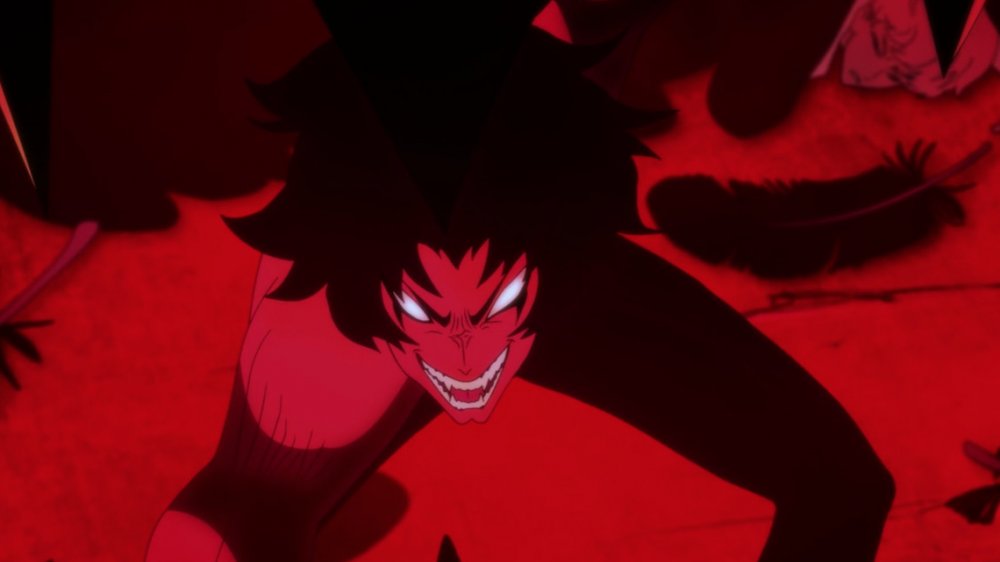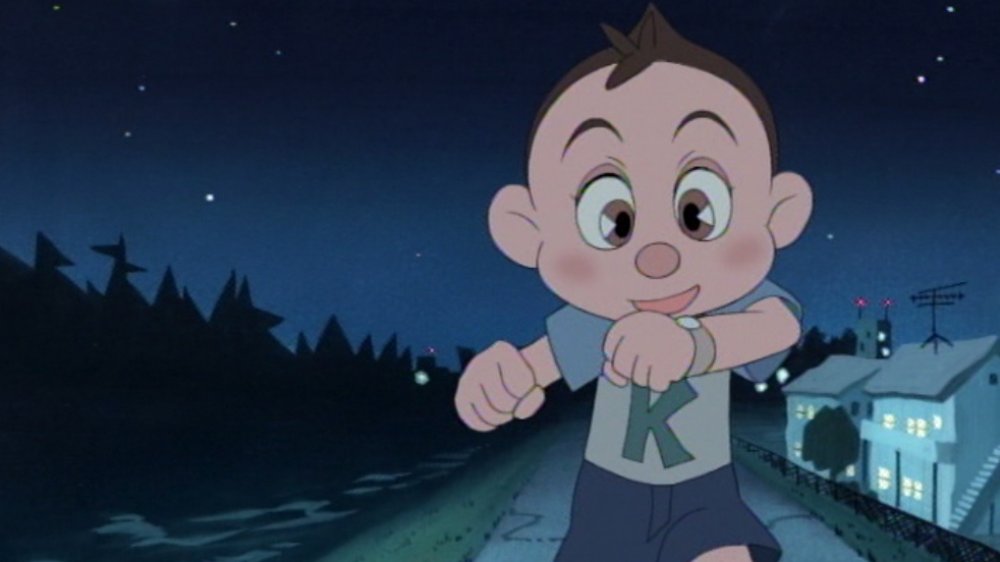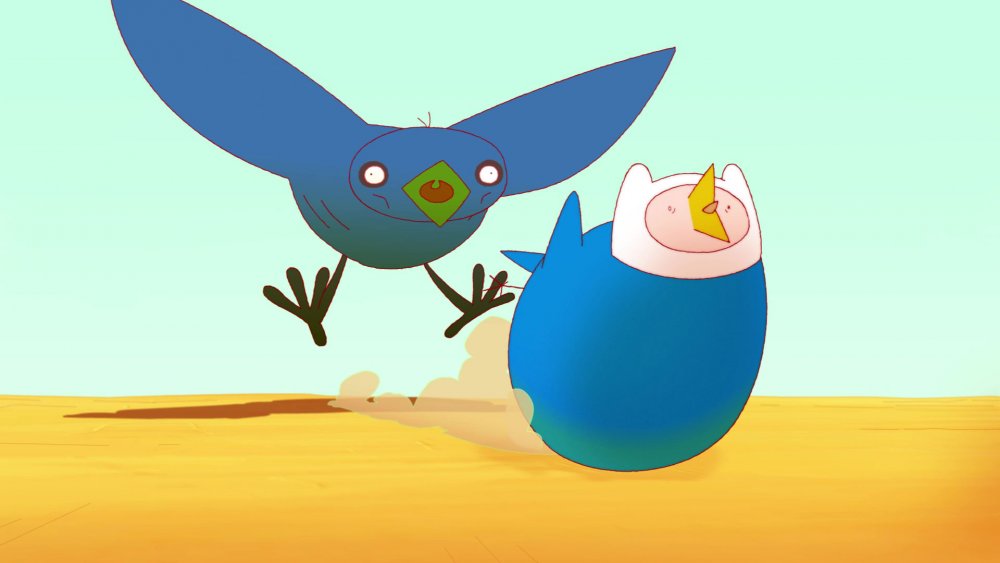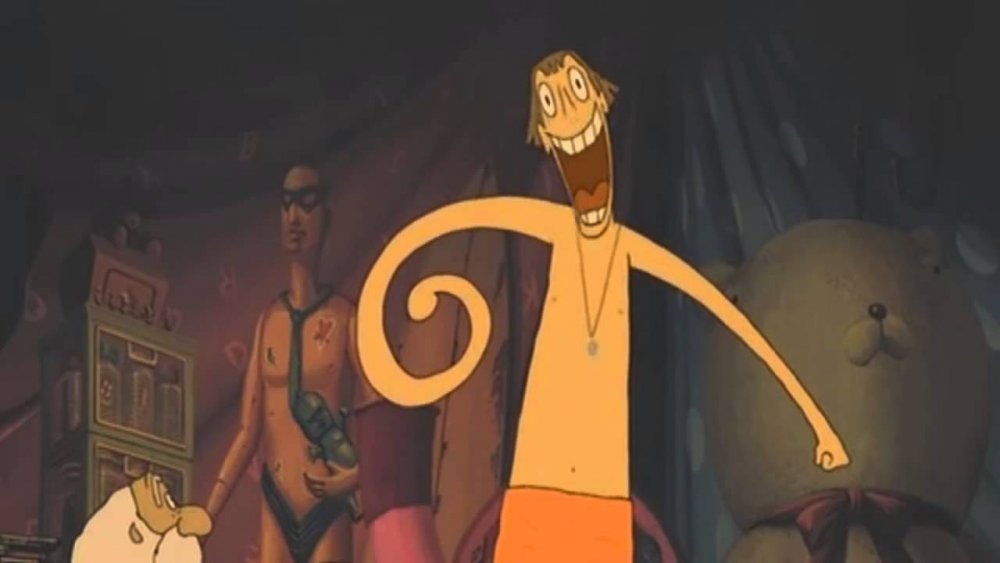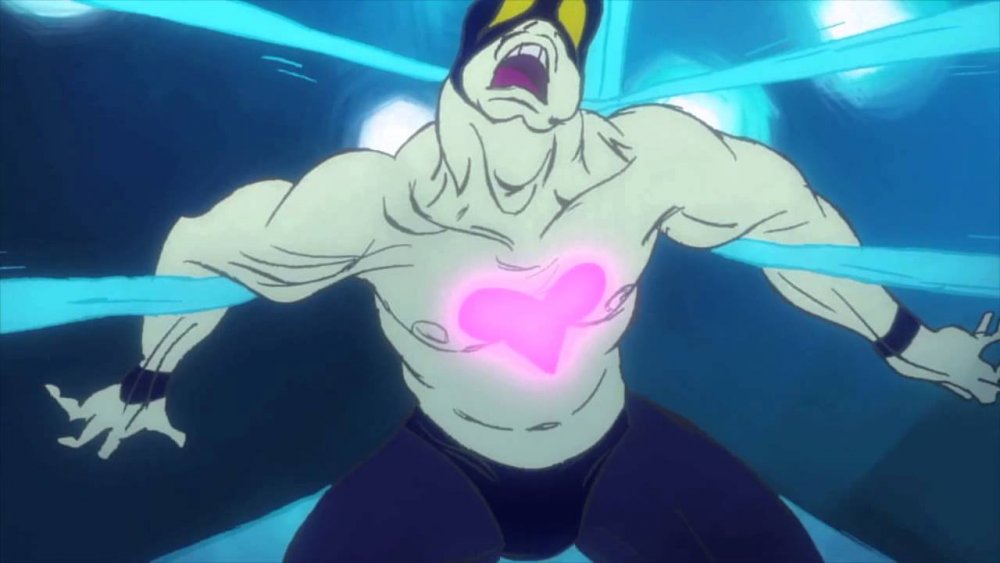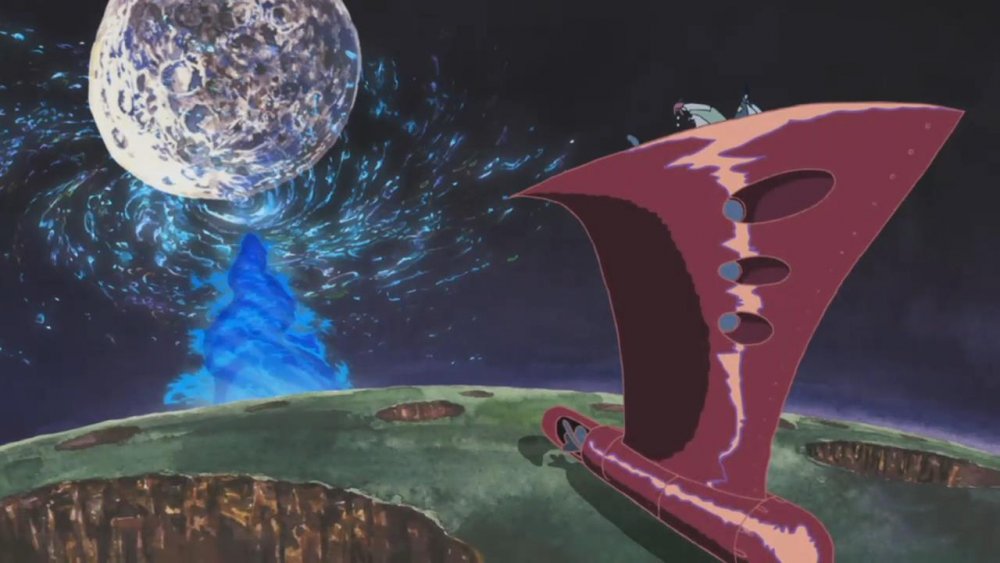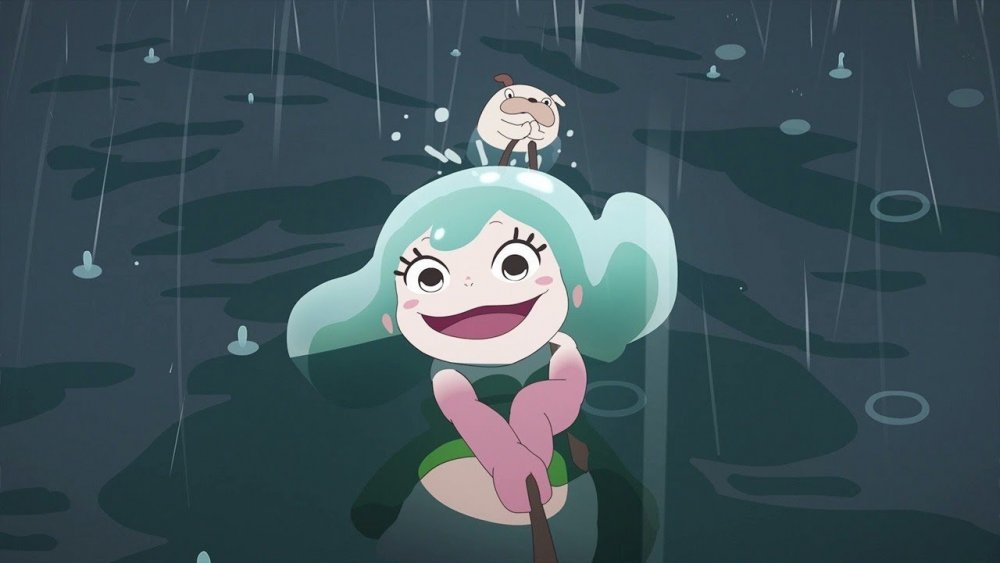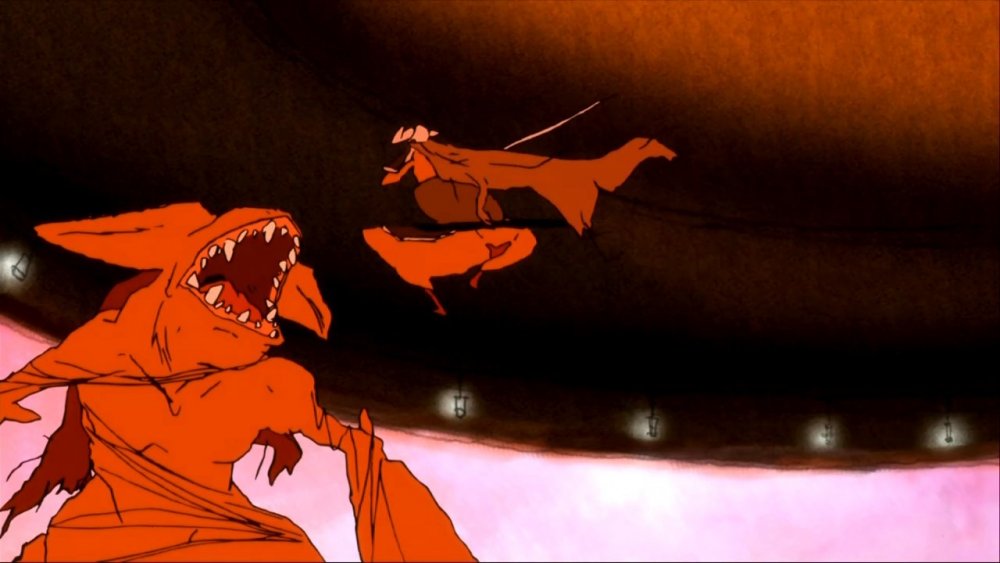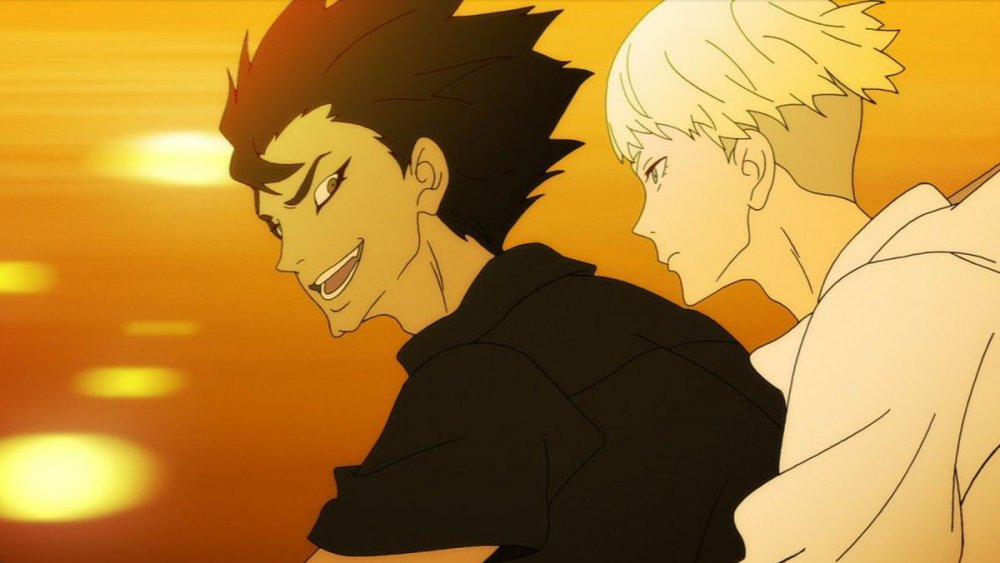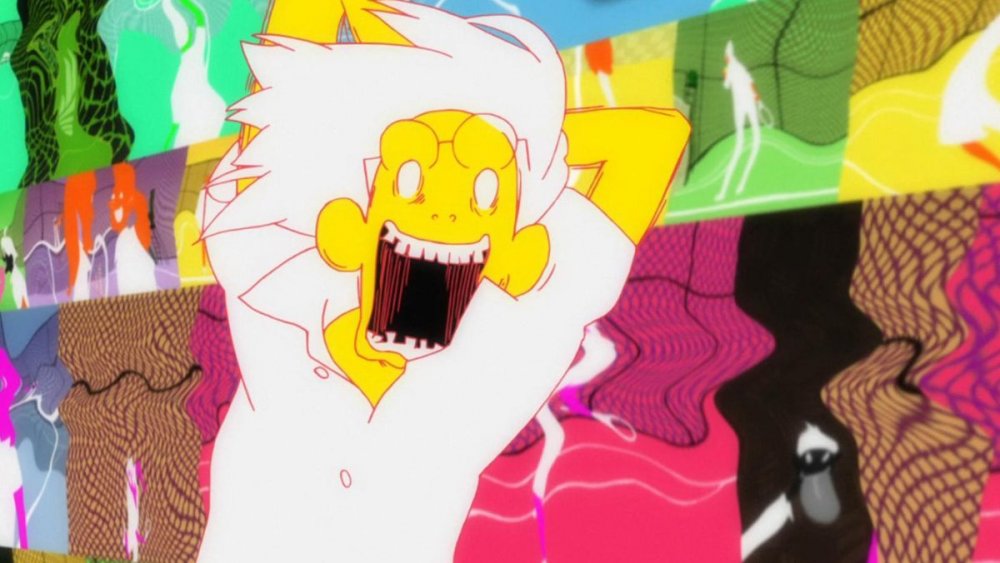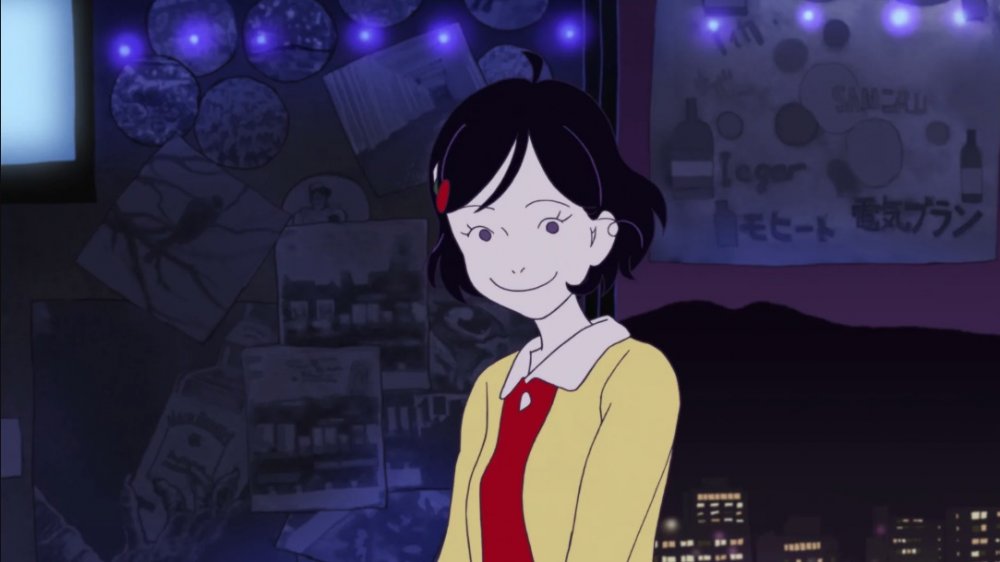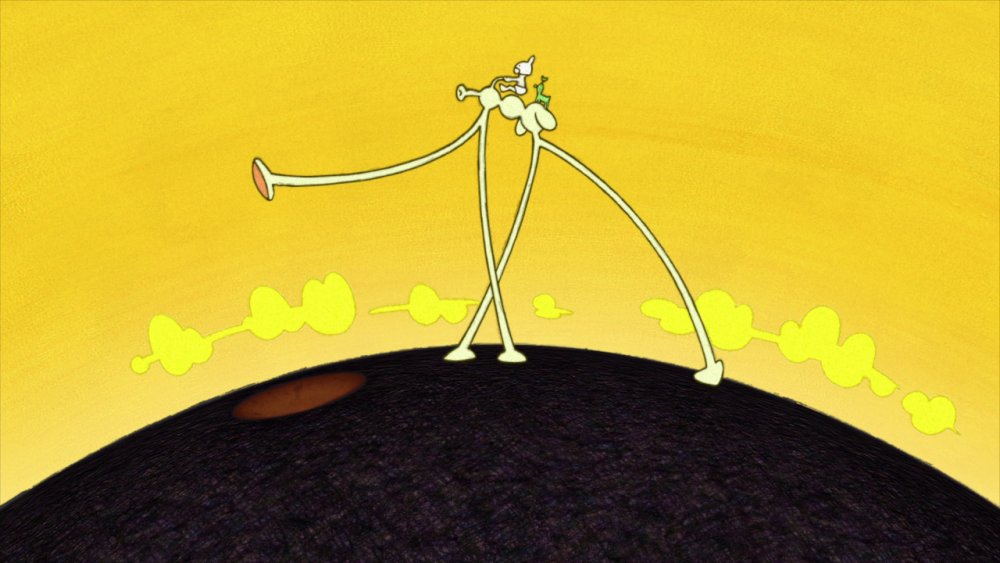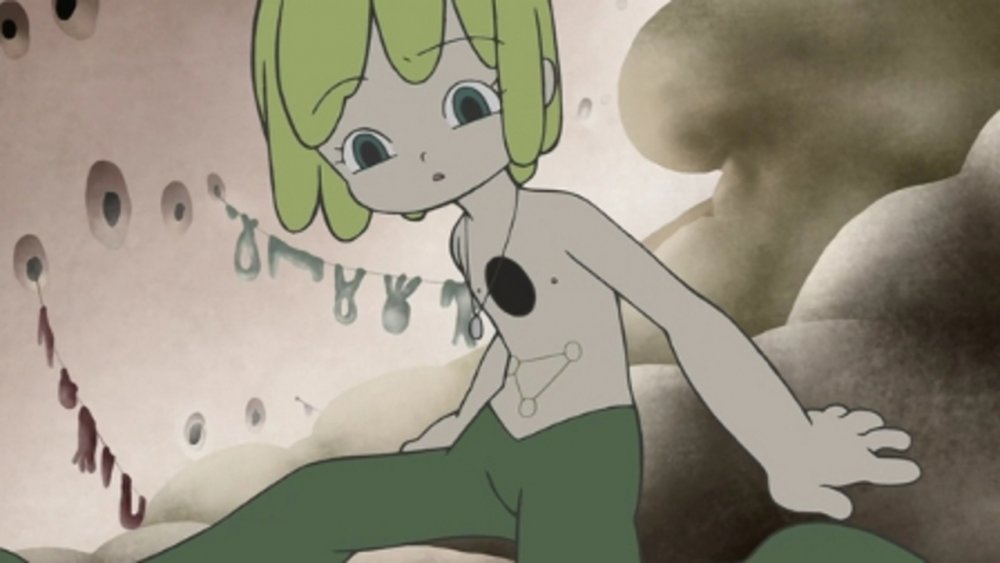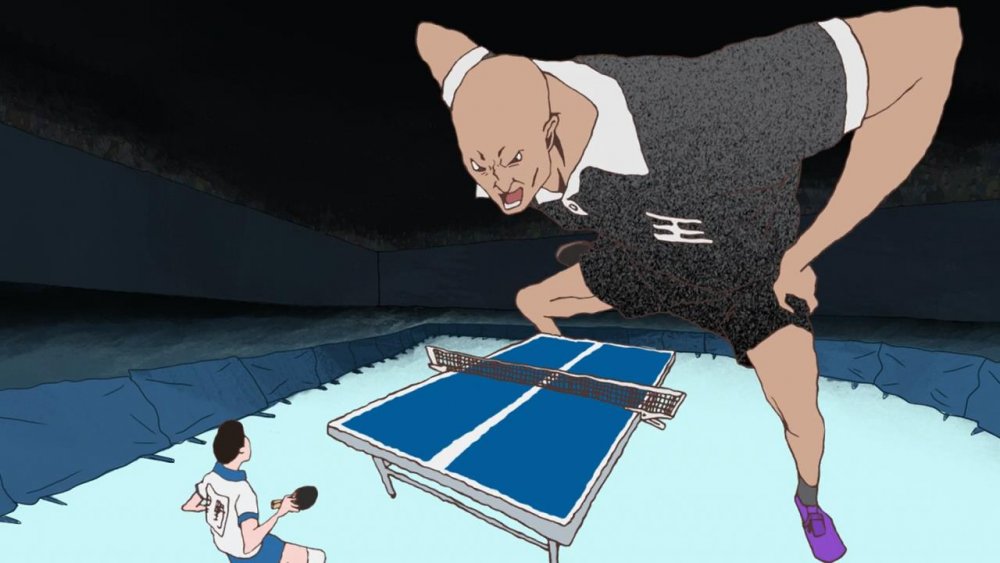Masaaki Yuasa Projects Ranked Worst To Best
For over two decades, Masaaki Yuasa has been one of the most exciting talents in Japanese animation. Yuasa's freeform, frenetic animation style is immediately recognizable, especially among the occasionally staid character designs and limited budgets of lesser anime. As a director, his projects almost seem unhinged in their commitment to style and emotional reality. In short, a Masaaki Yuasa project genuinely looks, sounds, and feels like nothing else.
While he cut his animating teeth in the '90s on various projects, it's as a director that Yuasa really shines. His creations are wildly varied: He's made everything from gore-drenched action-horror anime series to legitimately heartwarming children's movies, but his unique sensibilities always shine through regardless of the genre. Yuasa's served as a director for over a dozen projects, with varying degrees of creative control past that. But in considering all those years of work, there are bound to be some misfires among the masterpieces; with that in mind, here are Masaaki Yuasa-directed projects ranked worst to best.
The Vampiyan Kids pilot film is an interesting early work
Masaaki Yuasa's first official project as a director was the pilot for Vampiyan Kids, which follows a boy named Kou who stumbles into a haunted manor where a young vampire girl named Sue lives with her vampire father and witch mother. Although his animation style is visible in some of his earlier projects — notably, My Neighbors The Yamadas, a somewhat lesser-known Studio Ghibli film — Vampiyan Kids is the birth of the Yuasa style as we know it.
The plot is really an excuse to pack in as much physical comedy as possible, from the Inspector Gadget-like vampire hunter to Sue's constant attempts to keep her father from eating Kou. There are some excellent visual moments in the pilot, especially as the vampire hunter sprints through an entire floor of the haunted castle in order to leap onto the back of his flying dog robot. However, the plot's too rushed, and the characters too light; Yuasa's best work happens when the characters are almost as unhinged and wild as the art style. Finally, while it isn't necessarily Yuasa's fault, it's a shame that the Vampiyan Kids show that emerged from the project barely even resembles the look and feel of Yuasa's 18-minute pilot. All the weird edges and grotesque humor of the pilot was replaced with a fairly standard Dr. Slump ripoff in the actual series. All together, Vampiyan Kids is a project that's most likely to be of interest to diehard fans, but it's not a good entry point for anyone looking to understand Yuasa's unique appeal.
Adventure Time's "Food Chain" episode is wild and wacky
Adventure Time might not be the first place you'd think to find an original Masaaki Yuasa animation, but there he was anyway in the season six episode, "Food Chain." Even while showcasing his animated style in an American children's cartoon, the episode is as true to form as you can get, with grotesque, disturbing implications, trippy visuals, and whip-smart comedic timing. However, the story behind Masaaki Yuasa's Adventure Time guest spot is almost better than the actual episode.
Minty Lewis, a storyboard artist on Regular Show and the voice of the caterpillar in "Food Chain," told Newsarama that the episode was almost entirely the brain child of Yuasa alone. According to Lewis, "It seemed like they put a lot of trust in Masaaki Yuasa to make something amazing without really understanding what he was doing until he was done." Considering how the actual episode turned out, we can't blame the Adventure Time crew for not totally understanding what Yuasa was working on. "Food Chain" feels like a deranged fever dream, as Finn the Human and Jake the Dog experience the food chain, jumping from body to body as they eat and are eaten in turn. The whole thing wraps up with a song, and Finn and Jake presumably agree offscreen to never discuss the time that Finn married a caterpillar right before she was eaten by birds. Still, as cool as it is to see Yuasa tackle an American cartoon without having to adjust his style at all, the 11-minute runtime of Adventure Time episodes is a bit limiting. Yuasa's best work tends to be in projects that have time to breathe in a unique world, and "Food Chain" is just a bit too brisk to rank it any higher.
Mind Game is a trippy watch
Mind Game might be Masaaki Yuasa at his most manic, telling a story so fast-paced and strange that it's almost impossible to summarize in a simple way. Still, we'll give it a try. The story follows Nishi as he reconnects with his childhood crush Myon, experiences jealousy at Myon's engagement to another man, and is then murdered by a yakuza looking for Myon's father. Nishi wakes up in the afterlife, meets God, comes back to life, murders the yakuza that murdered him in a now alternate timeline, and speeds off in a yakuza's car with Myon and her sister. It's also sort of a retelling of the story of Jonah and the whale, and also about the sensation of losing the potential you had in youth.
While the bizarre plot can be credited to manga author Robin Nishi's source material of the same name, Mind Game has arguably the most trippy and disorienting visuals of Yuasa's career. Explosions of rainbow watercolors splash out of a couple making love, God can't decide on a shape to wear (or Nishi can't decide what God looks like), and the only way to escape a giant whale is to run on the molecules in the air. Unfortunately, while it feels a bit like the best music video you've ever seen, it's also almost two hours long, with a pacing and plot that seems to delight in confounding and frustrating the viewer. For anyone on the right wavelength, Mind Game is undoubtedly a delight. For everyone else, it's the slightly more tempered Yuasa projects that will really shine.
Kick-Heart is grotesque and gorgeous
One of the core appeals of Masaaki Yuasa's work is the interplay between a kind of ambiguous physicality and an emotional core that seems immovable. It seems like a simple concept when written out, but Yuasa's focus on the emotional reality of the scene is what lets him explore the possibilities of unreal physical spaces and bodies. One of the best examples of that is in Kick-Heart, a Kickstarter-funded short film about a masked wrestler, Masked M, who falls in love with his sadistic opponent, Lady S. The short starts with Masked M fighting against a monstrously large opponent, a wrestler that looks and feels more like King Hippo from Punch-Out!! than an actual human being. It's not that she's actually big, but rather that she feels big. Within the world of animation, almost anything's possible, and Kick-Heart's wrestling ring includes giant wrestlers and skyhigh piledrivers. Of course, Kick-Heart's not all animated inspiration; it's also a sort of S&M love story between two masked wrestlers who can only get their kicks by kicking or being kicked. Kick-Heart is beautifully animated, consistently grotesque, and sounds like a joke when you try and talk about it out loud to someone; in other words, it's vintage Yuasa.
The Space Dandy episode "Slow And Steady Wins The Race, Baby" is a great ride
Similar to Adventure Time's "Food Chain" episode, Space Dandy's "Slow And Steady Wins The Race, Baby" saw Masaaki Yuasa pop in for a one-off episode in a long-running animated series. Like Adventure Time, Space Dandy has a continuity that can be best described as "extremely loose," giving Yuasa more or less free rein to run wild with a character whose only motivations are to have a good time and maybe meet some new aliens. The episode follows Dandy and his crew as they find a teleportation device that accidentally sends Dandy to a planet populated by a talking fish. Well, to be more accurately, it sends Dandy's head to the planet, while his body remains on the ship until his friends realize they need to aim the teleportation device light at the rest of his body.
While the teleportation device leads to some fun visuals, the episode really kicks off once the gang realizes that the planet is going to be burned to nothingness by a nearby rotating star. The only way off the rapidly cooking planet is to ride a cascading waterfall in a sequence that showcases some of the best flowing water animation of Yuasa's career (at least until Lu Over The Wall). In keeping with the usual tone of Space Dandy, the climax is more of a half-hearted shrug at how odd the universe is, but the joy of the episode is seeing Yuasa put his unique stamp on a series that prides itself on "anything goes" rules.
Lu over the Wall is cute fun
Lu over the Wall isn't Masaaki Yuasa's most unique project. In terms of plot, it bears more than a passing resemblence to Hayao Miyazaki's Ponyo, which Yuasa himself has acknowledged. The plot, which sees a pessimistic middle schooler learn to appreciate life by forming a band and making friends with a young mermaid, is pretty predictable, even for children's animation. Even the unique aspects of the mermaids in Lu — that they burn in the sun and turn whatever they bite into mermaids — make the film feel a little like a big-budget remake of Yuasa's Vampiyan Kids. However, even with all the obvious flaws, it's an absolutely gorgeous visual experience.
Yuasa's art style has always been about flowing motion and big emotions, and Lu takes those tenets to their logical conclusion. Lu's ability to control water leads to some of the best visuals of Yuasa's career, with set pieces that rival Miyazaki for their impressive ambition. Even the story, as predictable as it might be, is given a certain measure of respect. There's no winking to the audience, no ironic distance or grotesque humor to dull the emotional weight. At its core, Lu over the Wall is about creation and friendship, and how those projects you make with your friends don't need to last forever to change your life. It's maybe Yuasa's most purely emotive film, and certainly one of the few projects he's worked on that's entirely kid-friendly.
Kemonozume is unhinged and vicious
At first glance, Kemonozume feels like a raw, wilder prototype of the kind of storytelling that Masaaki Yuasa would later perfect in Devilman Crybaby. Like the latter, Kemonozume is hyper-violent and almost garish in its sensibilities, even as the scope widens to tell a more nuanced story. Of course, that more nuanced story still involves a demon-hunting samurai with bowel issues. Kemonozume tells the story of the Kifūken clan, a group of swordsmen tasked with hunting and killing man-eating beasts called shokujinki. One member of the clan, Toshihiko, falls in love with a female shokujinki named Yuka, and their monster-hunter Romeo and demonic Juliet romance is the driving force in the series.
Kemonozume has an interesting aesthetic; it's scratchier and wilder than any other work that Yuasa's worked on since. Even the color palette is steeped in a neon-drenched battle between blues and reds that feels impossibly cool. Still, the story's nearly as unhinged as the characters (did we mention the swordsman with bowel issues?), with major moments and character developments happening between scenes as if a part of the script was just missing. It's an interesting early work of Yuasa's for sure, but it's way too hit or miss to rank any higher on this list.
Devilman Crybaby is devilish good fun
Based on the Devilman manga by Go Nagai, Devilman Crybaby is Masaaki Yuasa embracing pure grindhouse excess. The series follows Akira, who fuses with a devil to become Devilman as he helps his friend Ryo fight other devils. While the plot more or less follows Nagai's original work, Yuasa bumps up the gothic overtones and gruesome violence to absurd levels. A nightclub becomes engulfed in demonic energy as sex and violence become catnip for devils. A newly ripped Akira finds that he runs like Sonic the Hedgehog during track and field events. A psuedo-Greek chorus of rappers discuss the modern age, while Devilman Crybaby implies that maybe it's man who is the real monster.
Yuasa's not pulling any punches in this gothic opera, and Devilman Crybaby is definitely not for everyone. It's got enough sex and violence onscreen to put off both fans of the original Devilman and anyone hoping for a more conventionally superheroic show. Everything in Devilman Crybaby is dialed up to 11, from the fight scenes to the emotional beats. Still, for anyone willing and able to follow Yuasa on this wild ride, you're in for a treat.
The Tatami Galaxy shows an entire world in a room
The Tatami Galaxy follows an unnamed protagonist in college who, after two years wasting his life in a club that's offered him little in the way of social or personal happiness, wonders what it would be like if he'd chosen a different club when he first entered college. The hook of Tatami Galaxy is that the viewers get to see how it would actually turn out as episodes jump between parallel universes to show the new and exciting ways that the unnamed protagonist wastes his college years. It's an overwhelming show.
Not necessarily because of the series' plot — anyone familiar with movies like Groundhog Day and Happy Death Day or shows like Russian Doll shouldn't have trouble following the flow. No, Tatami Galaxy is overwhelming because of the sheer speed at which information is communicated. The unnamed protagonist delivers rapid-fire exposition so quickly that even the fastest readers will have a bit of trouble following the subtitles. You don't have a chance to focus on the words you're reading, however, because the animation is almost as fast-paced with an absurd amount of visual gags, action, and shifting character relationships. It's almost like actually experiencing an entire alternate life in 20-ish minutes, which is undoubtedly the point. However, The Tatami Galaxy isn't really about the overload of information or experiencing parallel realities; it's about learning to value the things you have and the people you know instead of wondering about what other possibilities you've missed out on. It's a moral that feels as well-earned for the protagonist as it does for the viewer by the time the credits roll on the final episode.
The Night Is Short, Walk On Girl is a self-contained masterpiece
A spiritual sequel to The Tatami Galaxy, The Night Is Short, Walk On Girl is an improvement on the former in nearly every way. Character designs, background visuals, and even the setting and tone all carry over from Tatami Galaxy, but Night Is Short manages to take everything great about the series and hone it into a fine point. The movie follows an unnamed girl who, on a drinking binge through Kyoto, meets a wide cast of bizarre characters while an unnamed boy tries to work up the courage to ask her out on a date. The Night Is Short is frequently hilarious, with some of the funniest visual gags in Yuasa's long career, but the tone is where Yuasa really succeeds.
As much as Tatami Galaxy can be overwhelming and nearly nihilistic at times, The Night Is Short manages to feel like exploring a city on a night where anything can happen. In the world of The Night Is Short, a wild night out involves drinking contests against pants-stealing mob bosses and alliances with the God of the used book fair. It taps into a feeling nearly everyone has had, or at least wanted to have — a feeling that something exciting is right around the corner if you just get up to look.
Genius Party "Happy Machine" segment
Buried in a 15-minute segment on the animated anthology film Genius Party is "Happy Machine," the Rosetta Stone for Masaaki Yuasa's entire sensibility and storytelling style. "Happy Machine" follows a baby that realizes that its mother and its home are actually an alien machine mimicking an ordinary baby's room. That realization comes right as the entire thing starts to break down, depositing the baby on a desert world with anthropomorphic flame creatures, feces-loving plant dogs, and an entire complicated ecosystem of weird animals and landscapes. Ultimately, after aging into an old man with metal limbs and tattered patchwork clothing, the former baby comes across a new baby in a similarly broken alien machine. The old man puts himself into the device, activating it, and assuring that the baby will live in relative peace... for a while at least.
It's maybe the clearest summation of everything that Yuasa's interested in as a storyteller; from the beautifully clear narrative (told without a single line of dialogue) to the implication that everything repeats in a cycle that may never be broken, but can perhaps be adjusted or skewed by acts of selfless kindness. "Happy Machine" is cute and grotesque, charming and disturbing, heartwarming and incredibly sad. In other words, it's a Masaaki Yuasa project.
You won't forget Kaiba
A core theme of Masaaki Yuasa's work is the concept of push and pull between one's intrinsic character and an active effort to change. How much can a person change who they are? Is a person the sum of their experiences or can active intention change the past and the future? These are questions at the heart of Kaiba, Yuasa's original science fiction epic. In a world where memories can be copied and storied in memory chips and people can be given new bodies if they have the wealth, Kaiba follows a boy who wakes up with no memories and a hole in his chest. Kaiba switches bodies in the series nearly as often as Kaiba switches tones, taking the viewers and Kaiba himself on a madcap odyssey through space.
"The God of Manga" Osamu Tezuka's work is an obvious influence on Kaiba, both in the round, almost child-like figures and in the tonal balance between adult themes and an intrinsic optimism. There's other, slightly less obvious references to the works that inspired Kaiba from The Little Prince to The Nightmare Before Christmas, but it all blends together to become something more than the sum of its parts. Kaiba feels like Yuasa funneled everything he ever liked and found interesting into one original work. While Kaiba's influences are obvious, the series genuinely feels like something entirely new in the best way.
Ping Pong: The Animation is a genuine masterpiece
Taiyō Matsumoto is arguably the greatest living manga artist working today, an undeniable genius when it comes to comic book storytelling. Masaaki Yuasa is an absurdly creative visionary whose adaptations are so well-regarded that they sometimes overshadow the original author's work. Ping Pong brought them together into a combination so impressive it makes the word "masterpiece" seem tame in comparison.
Every single detail of Ping Pong is nearly perfect. Yuasa's work has never looked so fluid and emotive, while Matsumoto's subtle character work in the manga perfectly balances with Yuasa's frenetic pace. Even the score, composed by Kensuke Ushio, is masterful, giving each character a musical theme that melds and mixes with other characters as they play and interact.
The characters feel like friends, their joy is contagious, and their frustrations are heartbreaking. Even while adapting a work as beloved as the Ping Pong manga, Yuasa still manages to stay true to the themes that have stayed with him through his entire career. What meaning does a moment hold, especially when that moment doesn't really decide your future? It's a question without a real answer, but Ping Pong, and Yuasa's career in total, seems to suggest that all the moments have meaning, individually and totally. It just requires you to realize that to change your life.
